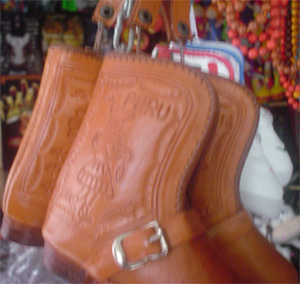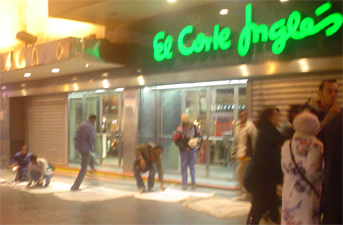TABLE
OF CONTENTS
|
White vs. Black: Africans in
Spain
By Carmina Osuna
After a couple of hours in Spain
I was excited because I felt somewhat at home. This
is because just like at home with my parents, I had
to speak
Spanish in order to communicate. After
the first two days however, I found myself in a country much like the
United
States in a global sense, and realized that I felt at home not only
because I
spoke Spanish but because the patterns of migration and globalization
were as
apparent in Spain as in the U.S. Spain,
the country known for its bull fights and flamenco dancers, is as
culturally
diverse as is the U.S.
Two of my
friends and I booked three beds from two different hostels in Madrid. The first hostel was located in what reminded
me of a small China
town in the U.S. The streets surrounding the hostel were
filled with Chinese and other Asian restaurants. While
we were looking for a costume for my
friend, who said she’d need them while in England,
we managed to stumble upon wholesale stores owned and run by Chinese
people. When I first stepped into the
store I wasn’t sure if I should speak English or Spanish or maybe ask
if they
spoke English or Spanish in the little mandarin that I know, ni shuo ingwen ma? I asked
the shopkeeper in Spanish first and
she spoke Spanish pretty clearly. I have
to admit that at first I was shocked that they didn’t speak English,
but then I
realized that it made sense for them to learn Spanish before any other
language
because we were in Spain,
not the U.S. This was the point in the voyage when I
experienced first hand that migrants do in fact adapt to the culture of
the
country of immigration. 
The next
day, on our way to the Sofia
museum,
we stumbled upon an outdoor market. The
vendors were mainly from Latin American countries like Chile
and Peru. I was surprised to find so many Latin
American people. Perhaps my surprise was
because our global studies course on the ship had ingrained in my mind
that
Spain is a European elite country, which I associated with very light
skin and light
colored eyes and no real interest in welcoming any foreigners. During my shopping I came across a female
vendor who was originally Chile. She told me that she had only been in Spain
for a year and that she and her family traveled to different countries
selling
their wares. On the table in her stand
she had earrings originally made in Chile
along with items from India,
Egypt,
and Spain.
Later on that night, my friends and
I decided to do some shopping in the downtown of Madrid.
After all the stores had closed and the people were walking to coffee
shops to
have their traditional churros con
chocolate, we noticed about seven dark skinned men who appeared to
be of African
descent. They had placed square white
sheets on the ground, just like the Filipinas in Hong Kong had done,
but
instead of spending some quality time they began to place handmade
jewelry and
perfumes on the white sheets for sale. The
native Spaniards became apparent because they just
looked down the
road without turning and walked right passed the African vendors. The foreigners, including ourselves, were so
shocked and curious at this obvious routine these men regularly go
through. I pulled out my camera to take
a picture and when they noticed they began to yell at me to stop. I quickly turned around and my friends said
they, “must be doing something illegal”. 
My
reflections of this day reminded me of Liliana Suarez Navaz’s book, Rebordering
the Mediterranean, where she talks
about
those who belong in the community in Andalucia and those who do not (6). In her introduction she describes how the
locals
saw the blacks and moors as “weird” people and understood why Navaz
would be
studying them yet when she started to study the Spaniards themselves,
they
became uncomfortable (14). I thought
back and saw myself in a difficult place. I
was caught between being the girl who had blended in
because she spoke
Spanish and had some Spanish blood in her from long ago, and the one
who could
relate to the black men who were seen as outsiders.
In the Los Angeles
area I see and experience discrimination in many distinct places and
situations
much like the African immigrants do in Spain. I can’t help but wonder where the ideal of
“white” superiority over the “dark” was generated and how it became
this ongoing
problem. I’ve been in their shoes as a
member of a migrant family, but where do we go from here?
|


